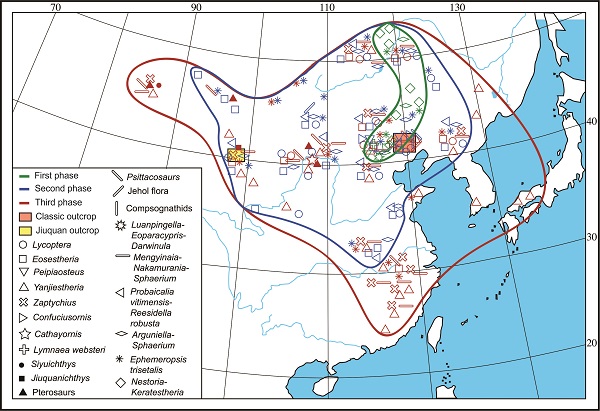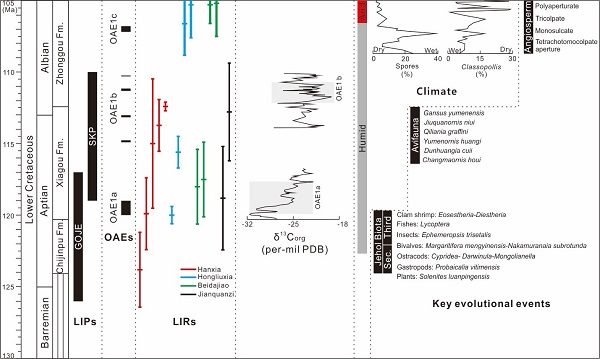With a depositional history spanning the early Aptian to early Albian (~19 mys), the Lower Cretaceous Xinminpu Group in Jiuquan, NW China provides detailed record of an inland ecosystem responding to global climatic and environmental changes. The Xinminpu Group exhibits the most typical elements of the Jehol Biota found outside NE China, a highly diverse avifauna and a mid-Cretaceous angiosperm flora. The absence of a comprehensive stratigraphical framework for this area however limits the degree to which the unit can be interpreted relative to coeval sections and the geological records in genera.
In the recent years, Dr. ZHENG Daran, Dr. LI Sha and Prof. ZHANG Haichun, from the research team of ‘Modern terrestrial ecosystem origin and early evolution’ of Nanjing Institute of Geology and Palaeontology, Chinese Academy of Sciences (NIGPAS), have carried out detailed geological investigations for the Lower Cretaceous in Jiuquan, NW China. About ten thousand fossils and rock samples were collected and analyzed for biostratigraphy, chronostratigraphy and geochemistry. A new comprehensive stratigraphical frame was provided for further discussing the inland biota evolution and environmental events. This research was recently published online in Earth-Science Reviews, and the main results of this research include:
First, this framework suggests that the Chijinpu Formation correlates with the middle-upper Yixian and lower Jiufotang formations in western Liaoning, NE China and formed during the early Aptian (~124-120 Ma). The Xiagou Formation correlates with the upper Jiufotang and Shahai formations in western Liaoning and was deposited during the late early Aptian to earliest Albian (~120-112 Ma). The lowermost Zhonggou Formation was dated at 112.4 ± 0.3 Ma and thus may be contemporaneous with the Fuxin Formation in western Liaoning, which is of early-middle Albian age.
Second, the typical Jehol Biota elements, namely the Eosestheria-Lycoptera-Ephemeropsis trisetalis assemblage, reached the Jiuquan area during the early Aptian and were preserved in the Chijinpu Formation. This early Aptian assemblage corresponds to the second and third evolutionary stages of the Jehol Biota.
Third, a newly reported U-Pb age of 112.4 ± 0.3 Ma combined with previous Early Cretaceous volcanic ages for Jiuquan units demonstrate several periods of volcanic activity during OAE1a and OAE1b. The Hongliuxia craters were probably the eruption center for basalts emplaced around the Jiuquan and Changma basins. This more detailed chronostratigraphical framework will help strengthen correlations between inland and marine environments as recorded in sediments from this critical period of Earth history.
Forth, the Ornithuromorpha-dominated avifauna from the Xiagou Formation of the Changma outcrop is similar to but more derived than the avifauna found in the Yixian and Jiufotang formations. The Changma avifauna appears just above OAE1a indicating that the early Aptian global climate change probably enhanced the evolution and diversification of early birds in this area.
This study reviewed previous geological information in Jiuquan and combined it with new systematic palaeontological and isotopic data to provide a consistent biostratigraphical and chronostratigraphical interpretation. It laid foundation for the systematic study of the well-preserved Early Cretaceous ecosystem in Jiuquan, allowing us to understand correlations between inland and marine environments as recorded in sediments from this critical period.
The research was supported by the Second Tibetan Plateau Scientific Expedition and Research, the General Research Fund of Hong Kong Research Grants Council, HKU Seed Fund for Basic Research, the Strategic Priority Research Program of the Chinese Academy of Sciences, the National Natural Science Foundation of China, and the State Key Laboratory of Palaeobiology and Stratigraphy (Nanjing Institute of Geology and Palaeontology, CAS).
Reference: Zheng Daran*, Wang He, Li Sha*, Wang Bo, Jarzembowski E.A., Dong Chong, Fang Yanan, Teng Xiao, Yu Tingting, Yang Lichao, Li Yuling, Zhao Xiangdong, Xue Naihua, Chang Su-Chin*, Zhang Haichun * (2021). Synthesis of a chrono- and biostratigraphical framework for the Lower Cretaceous of Jiuquan, NW China: implications for major evolutionary events. Earth-Science Reviews, 213, 103474. https://doi.org/10.1016/j.earscirev.2020.103474.

Figre1. Distribution and expansion of the Jehol Biota (map revised after Chen, 1999)

Figure2. Biostratigraphy of the Lower Cretaceous Xinminpu Group of the Jiuquan

Figure3. Early Cretaceous evolutionary and environmental events in Jiuquan
